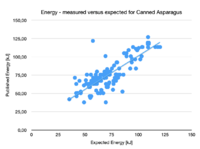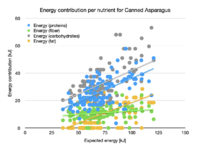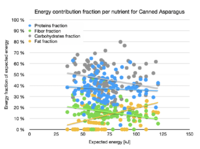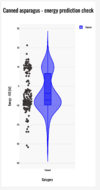Nutrients/Energy (expected-ico)
The energy of a product is caused/produced by one or more of its ingredients, mainly fat, carbohydrates, proteins and fibre. The relation between the energy and these nutrients is straightforward and allows us to predict the energy from these nutrients. This gives us a check on the published energy of a product.
Formula
The official formula published by the EU (ICOAnnex 5) is: Energy = ((carbohydrates - polyols)*17) + (polyols * 10) + (proteins * 17) + (fat * 37) + (fiber * 8) + (alcohol * 29) With
- Energy in kJoule;
- carbohydrates in g/100g;
- polyols - the polyols which are counted as carbohydrates, but contribute less on g/100g
- proteins in g/100g;
- fat in g/100g;
- fiber in g/100g;
- alcohol in %Vol;
Examples
For specific simple categories the relation (fractions) between the nutrients is probably fixed. Thus each nutrient will contribute a certain percentage.
Canned Asparagus
The plot shows the published energy versus the expected energy for the category Canned Asparagus. As expected there is a pretty good relation between the two variables. The line shows the linear fit. There are a few products which lie well off the fit and should be marked as suspicious. Note that there seem to be two lines, one slightly lower than the other. This is more clearly visible when one plots the difference between the energies in a violin plot (see below).
Each nutrient contributes differently to the total energy. The plot shows what each nutrient actually contributes versus the total expected energy.
- Fat contributes up to 20 kJ, which corresponds to about 0.5 g/100g. This is often the upper fat limit of a product. Thus this contributes seems to only add some noise to the total calculation;
- Fiber contributes about 10 kJ to the total energy. The fit seems flat, but should pass through the origin of the plot (0,0). Why?;
- Proteins contribute a fraction that depends on the expected energy;
- Carbohydrates contribute the most to the total energy, which is also a fraction;
Instead of plotting the actual contribution, we can plot the fraction of energy that each nutrient contributes. Note that the scatter for all nutrients is very large.
- Fat contributes between 5% and 25%. Seems there is an issue with fat percentages reported on products. Should this be excluded from the contributions?;
- Fiber contributes between 20% and 10%;
- Proteins contribute 40%;
- Carbohydrates contribute some 50%;
Orange Juice
Data quality
The expected energy can be compared to published energy. If the two deviate too much, there will be an error in the ingredients. But what is too much? What boundaries should be used to claim this? Again some practical information is needed for various categories.
Canned Asparagus deviations
The image shows the difference the expected and published energies for the category Canned Asparagus. Only the products that have published fiber are included. The distribution is indeed around the expected zero with quartiles around ±10 kJ. There seem to be two groups: one around +10kJ and one around -8kJ. The spread seems very large (±20 kJ) for a product that is on average 75kJ. This implies that a boundary of ±30% is appropriate for this category, otherwise to many false positives will be tagged.



